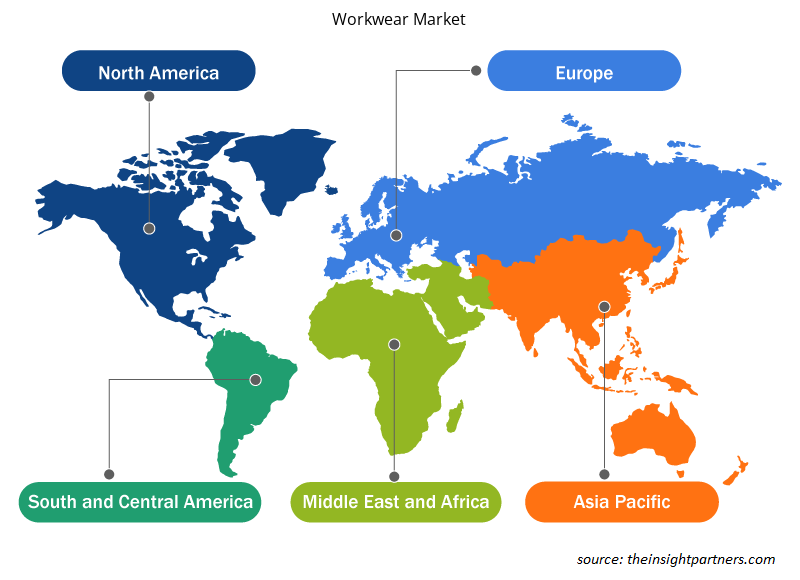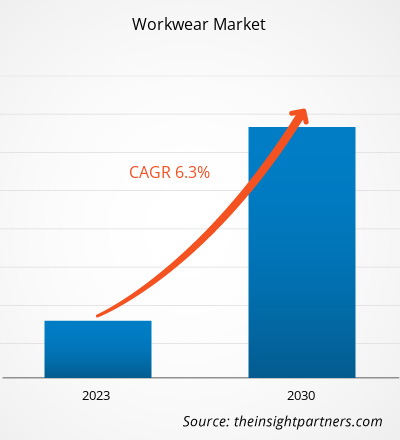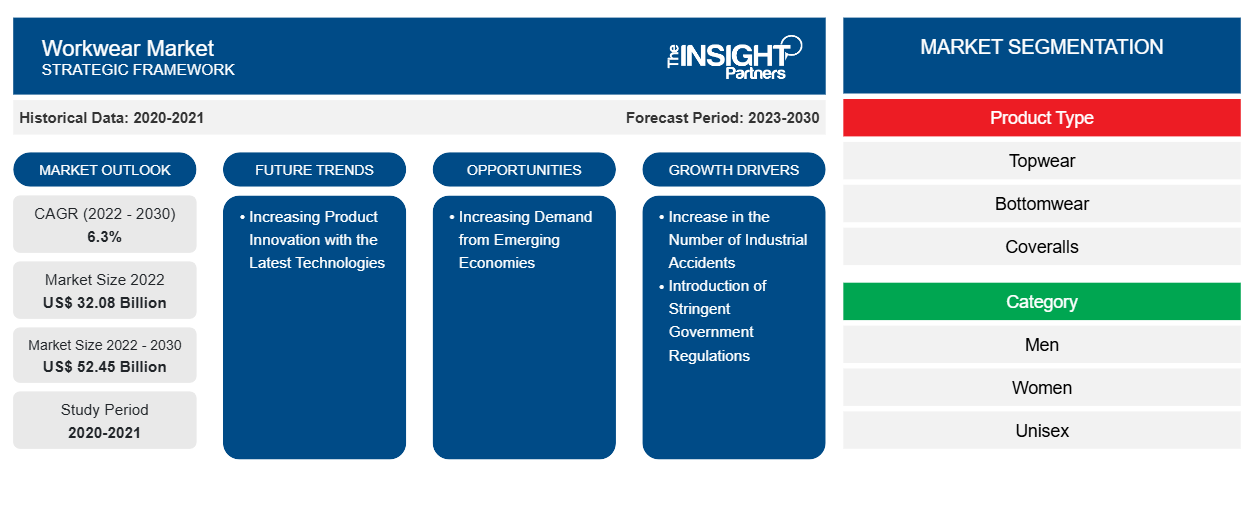[연구보고서] 작업복 시장 규모는 2022년 32,078.76백만 달러에서 2030년 52,448.15백만 달러로 성장할 것으로 전망되며, 2022년부터 2030년까지 연평균 성장률 6.3%를 기록할 것으로 예상됩니다.
시장 통찰력 및 분석가 관점:
작업복은 특히 육체 노동이 포함된 작업에서 착용하는 안전복과 유니폼입니다. 작업복은 근로자의 안전을 증진하고 건강한 작업 환경을 보장합니다. 작업복은 석유 및 가스, 화학, 규제, 의료, 호텔, 농업, 광업 등 다양한 분야에서 널리 사용됩니다. 지난 몇 년 동안 산업 분야에서 근로자 안전에 대한 우려가 빠르게 증가하고 있습니다. 다양한 정부와 안전 협회가 근로자의 안전을 보장하기 위해 산업 지침을 부과하고 있으며, 이로 인해 작업복에 대한 수요가 급증했습니다.
성장 동인 및 과제:
산업 사고는 다양한 산업 분야에서 주요 관심사 중 하나입니다. 이러한 사고는 인간의 건강에 심각한 영향을 미칩니다. 건설, 석유 및 가스, 광산과 같은 다양한 산업에서 수많은 글로벌 사고가 발생했습니다. 국제 노동 기구(ILO)에 따르면 매년 약 278만 건의 업무 관련 사망자가 기록되며, 그 중 240만 건은 직업병과 관련이 있습니다. 또한 전 세계적으로 매년 약 3억 4천만 건의 산업 사고와 1억 6천만 명의 업무 관련 질병 피해자가 발생합니다. 산업 사고가 증가함에 따라 고용주는 직장에서 직원의 웰빙과 안전을 보장하기 위해 국가 및 국제 기관에서 정의한 여러 표준을 채택하고 있습니다. 산업용 작업복은 사용자에게 보호와 편안함을 제공하고 직장에서 심각한 사망을 피하도록 설계되어 근로자의 작업 효율성을 향상시킵니다. 기능성 작업복은 다양한 산업 기반에서 작업하는 동안 안전과 내구성을 제공합니다. 이로 인해 산업 사고와 업무 관련 사망률이 증가함에 따라 근로자의 안전을 보장하기 위한 작업복에 대한 수요가 급증하였고, 이는 작업복 시장 성장에 기여하게 되었습니다.
또한, 근로자들 사이에서 직장 안전과 직장에서 발생할 수 있는 건강 위험에 대한 지식 부족은 전 세계적으로 심각한 우려 사항입니다. 이에 대한 인식을 높이기 위해 많은 정부 및 비정부 기구가 근로자의 건강과 안전과 관련된 다양한 프로그램과 캠페인을 도입하고 있습니다. American Standard Organization에 따르면 북미에서는 미국 노동부와 직업 안전 보건청(OSHA)이 직업 안전 보건 표준 분야를 표준화합니다. 보호복 표준 개발에 참여하는 기구로는 American Society for Testing and Materials(ASTM), National Fire Protection Association(NFPA), National Institute for Occupational Safety and Health(NIOSH), American National Standard Institute(ANSI), American Association of Textile Chemists and Colorists(AATCC), Industrial Safety Equipment Association(ISEA)가 있습니다. 따라서 직장 안전에 대한 인식을 높이는 것이 작업복 시장 성장을 크게 촉진합니다.
귀하의 요구 사항에 맞게 이 보고서를 사용자 정의하세요
이 보고서의 일부 또는 국가 수준 분석, Excel 데이터 팩을 포함하여 모든 보고서에 대한 사용자 정의를 무료로 받을 수 있으며 신생 기업 및 대학을 위한 훌륭한 혜택과 할인 혜택을 이용할 수 있습니다.
-
이 보고서의 주요 시장 동향을 알아보세요.이 무료 샘플에는 시장 동향부터 추정 및 예측까지 다양한 데이터 분석이 포함됩니다.
보고서 세분화 및 범위:
글로벌 작업복 시장은 제품 유형, 범주, 유통 채널, 최종 용도 및 지역에 따라 세분화됩니다. 제품 유형별로 시장은 상의, 하의, 작업복으로 세분화됩니다. 범주별로 시장은 남성, 여성, 유니섹스로 나뉩니다. 유통 채널 기준으로 시장은 도매업체, 슈퍼마켓 및 하이퍼마켓, 전문점, 온라인 플랫폼으로 세분화됩니다. 최종 용도 기준으로 시장은 건설, 석유 및 가스, 화학, 의료 및 기타로 구분됩니다. 지리적 기준으로 북미(미국, 캐나다, 멕시코), 유럽(독일, 프랑스, 이탈리아, 영국, 러시아, 유럽의 나머지 지역), 아시아 태평양(호주, 중국, 일본, 인도, 한국, 아시아 태평양의 나머지 지역), 중동 및 아프리카(남아프리카, 사우디 아라비아, UAE, 중동 및 아프리카의 나머지 지역), 남중미(브라질, 아르헨티나, 남중미의 나머지 지역)로 세분화됩니다.
세그먼트 분석:
제품 유형에 따라 작업복 시장은 상의, 하의, 오버올로 구분됩니다. 오버올 세그먼트는 예측 기간 동안 가장 높은 CAGR을 기록할 것으로 예상됩니다. 오버올은 직장에서 인체 전체를 보호하기 위해 입는 단일 또는 이중 의류입니다. 이러한 오버올은 주로 나일론, 면, 폴리아미드 섬유로 만들어집니다. 이들은 일반적으로 직업적 위험의 높은 위험으로 인해 페인트 및 코팅 , 석유 및 가스와 같은 화학 처리 공장 및 산업에서 사용됩니다. 이러한 요인들이 오버올 세그먼트의 시장 성장을 촉진합니다.workwear market is segmented into topwear, bottomwear, and coveralls. the coveralls segment is expected to register the highest CAGR during the forecast period. Coveralls are single or double pieces of clothing worn to protect the full human body at the workplace. These coveralls are mainly made from nylon, cotton, and polyamide fibers. They are generally used in chemical processing plants and industries, such as
지역 분석:
지리적으로 작업복 시장은 북미, 유럽, 아시아 태평양, 남미 및 중미, 중동 및 아프리카의 5개 주요 지역으로 구분됩니다. 북미는 글로벌 시장을 지배했으며, 이 지역의 시장은 2022년에 83억 6천만 달러로 평가되었습니다. 아시아 태평양 아메리카 시장은 예측 기간 동안 7.1%의 CAGR을 기록할 것으로 예상됩니다. 2021년에 국제노동기구(ILO)는 아시아 태평양에서 매년 110만 명 이상이 직업적 사고나 직업 관련 질병으로 목숨을 잃는다고 밝혔습니다. 인도와 같은 다양한 APAC 국가는 가장 보호가 부족하고, 정보가 부족하며, 훈련이 부족한 인력을 보유하고 있습니다. 여성, 어린이, 장애인 근로자, 이주 근로자, 소수 민족은 가장 큰 영향을 받는 집단이며 종종 직업적 사고에 연루됩니다. 따라서 이러한 직업적 사고와 부상을 줄이기 위해 건설, 제조, 석유 및 가스와 같은 여러 산업이 직원의 작업 안전에 광범위하게 투자하고 있습니다. 따라서 작업복에 대한 수요가 높아짐에 따라 아시아 태평양 지역의 작업복 시장이 크게 성장하고 있습니다.
산업 발전 및 미래 기회:
작업복 시장에서 활동하는 주요 업체가 취한 이니셔티브는 아래와 같습니다.
- 2020년 2월, Honeywell International Inc.와 Tech Mahindra Limited는 업계를 선도하는 디지털 기술을 활용하여 "미래의 공장"을 개발하고 구축하기 위한 파트너십을 발표했습니다. 이 협업은 디지털 혁신에 초점을 맞추고 제조 산업의 고객이 더욱 빠르게 확장할 수 있도록 지원합니다.
- 2020년 7월, Loyal Textile Mills Limited는 특히 SARS-CoV-2 바이러스에 대한 항균 활동으로부터 보호하는 재사용 가능한 PPE, 마스크, 보호복 제품군인 Viral Shield를 출시했습니다.
작업복 시장 지역 통찰력
Insight Partners의 분석가들은 예측 기간 동안 워크웨어 시장에 영향을 미치는 지역적 추세와 요인을 철저히 설명했습니다. 이 섹션에서는 북미, 유럽, 아시아 태평양, 중동 및 아프리카, 남미 및 중미의 워크웨어 시장 세그먼트와 지리에 대해서도 설명합니다.

- 작업복 시장에 대한 지역별 특정 데이터 얻기
작업복 시장 보고서 범위
| 보고서 속성 | 세부 |
|---|---|
| 2022년 시장 규모 | 320억 8천만 달러 |
| 2030년까지 시장 규모 | 524억 5천만 달러 |
| 글로벌 CAGR (2022-2030) | 6.3% |
| 역사적 데이터 | 2020-2021 |
| 예측 기간 | 2023-2030 |
| 다루는 세그먼트 |
제품 유형별
|
| 포함된 지역 및 국가 |
북아메리카
|
| 시장 선도 기업 및 주요 회사 프로필 |
|
작업복 시장 참여자 밀도: 비즈니스 역학에 미치는 영향 이해
작업복 시장 시장은 소비자 선호도의 변화, 기술 발전, 제품의 이점에 대한 인식 증가와 같은 요인으로 인해 최종 사용자 수요가 증가함에 따라 빠르게 성장하고 있습니다. 수요가 증가함에 따라 기업은 제품을 확장하고, 소비자의 요구를 충족하기 위해 혁신하고, 새로운 트렌드를 활용하여 시장 성장을 더욱 촉진하고 있습니다.
시장 참여자 밀도는 특정 시장이나 산업 내에서 운영되는 회사나 기업의 분포를 말합니다. 주어진 시장 공간에 얼마나 많은 경쟁자(시장 참여자)가 존재하는지 그 규모나 총 시장 가치에 비해 나타냅니다.
작업복 시장에서 활동하는 주요 회사는 다음과 같습니다.
- 카하트 주식회사
- 아라마크
- 알시코 그룹
- 알렉산드라
- A. 라폰트 SAS
면책 조항 : 위에 나열된 회사는 어떤 특별한 순서에 따라 순위가 매겨지지 않았습니다.

- Workwear Market의 주요 주요 업체 개요를 알아보세요
COVID-19 팬데믹 영향:
COVID-19 팬데믹은 다양한 국가의 거의 모든 산업에 부정적인 영향을 미쳤습니다. 북미, 유럽, 아시아 태평양(APAC), 남미 및 중미, 중동 및 아프리카(MEA)의 봉쇄, 여행 제한 및 사업 중단은 여러 최종 사용 산업 회사의 성장을 저해했습니다. 제조 단위의 폐쇄는 글로벌 공급망, 생산 활동, 납품 일정 및 필수 및 비필수 제품 판매를 방해했습니다. 다양한 회사는 2020년에 제품 납품이 지연되고 제품 판매가 침체되어 작업복 시장이 어려움을 겪었습니다. 인력 부족, 수출입 금지 및 원자재 공급 제한으로 인해 COVID-19 팬데믹 동안 전 세계적으로 운영 및 프로세스가 중단되었습니다. 이러한 요인은 팬데믹 동안 작업복 시장 성장에 부정적인 영향을 미쳤습니다.
그러나 2021년에 여러 정부가 이전에 부과한 제한을 철회하면서 다양한 경제권이 운영을 재개했고, 이는 글로벌 시장에 긍정적인 영향을 미쳤습니다. 게다가 제조업체는 최대 용량으로 운영할 수 있게 되었고, 이는 수요와 공급 격차를 극복하는 데 도움이 되었습니다.
경쟁 환경 및 주요 회사:
Carhartt, Inc., Aramark, Alisco Group, Alexandra, 3M, A. LAFONT SAS, Fristads Kansas Group, Hultafors Group, Lakeland Industries, Inc.는 글로벌 작업복 시장에서 활동하는 대표적인 기업입니다. 이러한 시장 기업은 전략적 개발 이니셔티브를 채택하여 사업을 확장하고 작업복 시장 성장을 더욱 촉진합니다.
- 과거 분석(2년), 기준 연도, CAGR을 포함한 예측(7년)
- PEST 및 SWOT 분석
- 시장 규모 가치/거래량 - 글로벌, 지역, 국가
- 산업 및 경쟁 환경
- Excel 데이터세트
최근 보고서
관련 보고서
사용 후기
구매 이유
- 정보에 기반한 의사 결정
- 시장 역학 이해
- 경쟁 분석
- 고객 인사이트
- 시장 예측
- 위험 완화
- 전략 기획
- 투자 타당성 분석
- 신흥 시장 파악
- 마케팅 전략 강화
- 운영 효율성 향상
- 규제 동향에 발맞춰 대응























 무료 샘플 받기 - 작업복 시장
무료 샘플 받기 - 작업복 시장